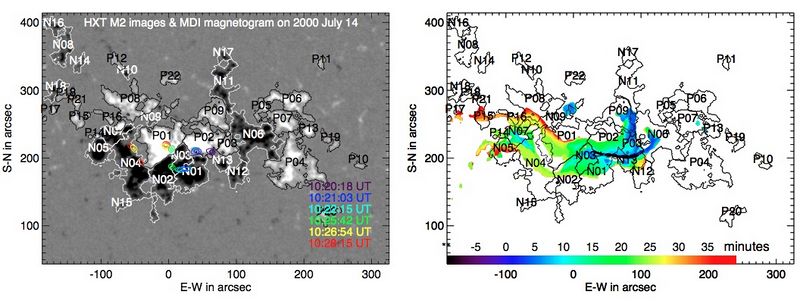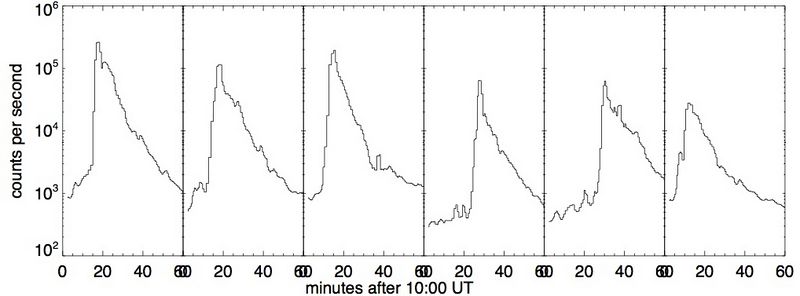Kernels and Ribbons
From RHESSI Wiki
(Draft thru Fig. 1) |
(More of the draft) |
||
| Line 31: | Line 31: | ||
[http://en.wikipedia.org/wiki/Bastille_Day_eventflare], which | [http://en.wikipedia.org/wiki/Bastille_Day_eventflare], which | ||
occurred at 10 UT on 2000 July 14, and was observed by [http://hesperia.gsfc.nasa.gov/sftheory/yohkoh.htm Yohkoh] and [http://trace.lmsal.com/TRACE] among others. | occurred at 10 UT on 2000 July 14, and was observed by [http://hesperia.gsfc.nasa.gov/sftheory/yohkoh.htm Yohkoh] and [http://trace.lmsal.com/TRACE] among others. | ||
| - | Figure 1 gives snapshots of the flare evolution that these satellites measured in hard X-ray and UV wavelengths, superimposed | + | Figure 1 gives snapshots of the flare evolution that these satellites measured in hard X-ray (left) and UV (right) wavelengths, superimposed |
| - | on an array of [magnetic poles] | + | on an array of [magnetic poles]. |
| - | The color code shows | + | This is a simple way to model the complicated solar magnetic field, and some of these artificial magnetic poles coincide with |
| + | the sunspots. | ||
| + | The color code shows the time | ||
evolution of UV brightening, which spreads both along the magnetic polarity inversion line (PIL) in | evolution of UV brightening, which spreads both along the magnetic polarity inversion line (PIL) in | ||
a nearly organized manner from the west to the east and perpendicular to and away from the PIL as would | a nearly organized manner from the west to the east and perpendicular to and away from the PIL as would | ||
| - | be expected in the 2D reconnection model. | + | be expected in the 2D reconnection model. |
| - | + | The >20 keV hard X-ray emission of the flare shows only 2 or 3 compact sources. | |
| - | emission of the flare | + | |
During the flare evolution, the hard X-ray sources gradually shift along the PIL, similar to | During the flare evolution, the hard X-ray sources gradually shift along the PIL, similar to | ||
| - | the evolution pattern of UV brightening | + | the evolution pattern of UV brightening. |
| - | + | ||
| - | + | ||
| - | + | ||
[[Image:129fig1.jpg|center|thumb|800px|Figure 1: Maps of the Bastille Day flare, superposed on an array of positive (P) and negative (N) poles used to characterize the solar magnetic field. | [[Image:129fig1.jpg|center|thumb|800px|Figure 1: Maps of the Bastille Day flare, superposed on an array of positive (P) and negative (N) poles used to characterize the solar magnetic field. | ||
| Line 49: | Line 47: | ||
Note that both emissions tend to have EW elongations lying in opposite polarities.]] | Note that both emissions tend to have EW elongations lying in opposite polarities.]] | ||
| + | == Discovery of UV "cooling" == | ||
| + | |||
| + | Generally, and in this case as well, the hard X-ray and UV emissions have strikingly similar time variations when viewed | ||
| + | as a whole, but in detail they may not agree. | ||
| + | The UV emission persists at low levels, filling out the ribbon structures even when the hard X-ray footpoints have disappeared | ||
| + | or moved elsewhere. | ||
| + | We have studied the time variation in individual pixels of the TRACE images and find a very suggestive pattern, which we illustrate in | ||
| + | Figure 2. | ||
| + | |||
| + | [[Image:129fig2.jpg|center|thumb|800px|Figure 2: UV time variations in individual pixels.]] | ||
| + | |||
| + | The individual pixels show a characteristic pattern. | ||
| + | At the beginning, there is an impulsive increase; following this, each pixel appears to decay exponentially in brightness. | ||
| + | We suggest that the UV emission, which rises nearly instantaneously | ||
| + | with the hard X-rays, is likely produced primarily by non-thermal electron precipitation, and the long | ||
| + | decay in the original UV total counts is not caused by newly brightened pixels after the decay | ||
| + | of hard X-rays, but by the elongated decay of individual pixels which have been instantaneously | ||
| + | brightened at time scales comparable to hard X-rays. | ||
| + | This could be identified with the cooling (or loss of excess energy in the form of gas pressure) | ||
| + | of magnetic loops formed as a part of the flare arcade. | ||
| + | The tendency for individual loops to have similar decay times would then correspond to the fact that the loops have | ||
| + | similar dimensions. | ||
| + | |||
| + | == Conclusions == | ||
The revisit raises some interesting questions. First, obviously, the evolution and mapping of UV and hard X-ray | The revisit raises some interesting questions. First, obviously, the evolution and mapping of UV and hard X-ray | ||
Revision as of 19:34, 13 June 2010
| Nugget | |
|---|---|
| Number: | 129 |
| 1st Author: | Jiong QIU |
| 2nd Author: | |
| Published: | 2010 June 14 |
| Next Nugget: | RHESSI coronal seismology |
| Previous Nugget: | Awesome Stellar Flare Spectra |
| List all | |
Contents |
Introduction
A solar flare has a complicated three-dimensional structure involving all layers of the solar atmosphere. Many of the models that we use to explain them, though, are inherently two-dimensional and indeed often involve the concept of the current sheet, geometrically a manifold with only two dimensions. On the other hand, modern theories of magnetic reconnection require three-dimensionality to make the plasma physics work.
Many of the observations also seem to point to intrinsic two-dimensionality. Chief among these are the flare ribbons, the magnetic footpoints of an arcade of loops that looks entirely consistent with the presence of a large-scale current sheet in the solar corona. One observation that generally does not agree with this picture is the hard X-ray picture (e.g. RHESSI's), and this one is fundamentally important to understand because the hard X-rays show us where the flare energy appears. Instead of ribbons, the hard X-rays usually show a much simpler structure, often two bright compact sources termed "footpoints" on the reasonable assumption that they show the two ends of a thin coronal magnetic loop. This nugget studies the fine structure of footpoints (seen in hard X-rays) and ribbons (seen in the UV) in a search for an answer to the simple geometrical (2D vs 3D?) question.
Revisiting the Bastille Day Flare
To explore the relationship between hard X-ray and UV emissions at the feet of flare loops, we revisit one of the best known two-ribbon flares, the Bastille day [1], which occurred at 10 UT on 2000 July 14, and was observed by Yohkoh and [2] among others. Figure 1 gives snapshots of the flare evolution that these satellites measured in hard X-ray (left) and UV (right) wavelengths, superimposed on an array of [magnetic poles]. This is a simple way to model the complicated solar magnetic field, and some of these artificial magnetic poles coincide with the sunspots. The color code shows the time evolution of UV brightening, which spreads both along the magnetic polarity inversion line (PIL) in a nearly organized manner from the west to the east and perpendicular to and away from the PIL as would be expected in the 2D reconnection model. The >20 keV hard X-ray emission of the flare shows only 2 or 3 compact sources. During the flare evolution, the hard X-ray sources gradually shift along the PIL, similar to the evolution pattern of UV brightening.

Discovery of UV "cooling"
Generally, and in this case as well, the hard X-ray and UV emissions have strikingly similar time variations when viewed as a whole, but in detail they may not agree. The UV emission persists at low levels, filling out the ribbon structures even when the hard X-ray footpoints have disappeared or moved elsewhere. We have studied the time variation in individual pixels of the TRACE images and find a very suggestive pattern, which we illustrate in Figure 2.
The individual pixels show a characteristic pattern. At the beginning, there is an impulsive increase; following this, each pixel appears to decay exponentially in brightness. We suggest that the UV emission, which rises nearly instantaneously with the hard X-rays, is likely produced primarily by non-thermal electron precipitation, and the long decay in the original UV total counts is not caused by newly brightened pixels after the decay of hard X-rays, but by the elongated decay of individual pixels which have been instantaneously brightened at time scales comparable to hard X-rays. This could be identified with the cooling (or loss of excess energy in the form of gas pressure) of magnetic loops formed as a part of the flare arcade. The tendency for individual loops to have similar decay times would then correspond to the fact that the loops have similar dimensions.
Conclusions
The revisit raises some interesting questions. First, obviously, the evolution and mapping of UV and hard X-ray sources reflect the pattern of magnetic reconnection which is not entirely 2-dimensional, and second, the coincident rise and peak but delayed decay in UV emission with respect to hard X-ray emission suggests some different physics, not directly related to hard X-ray producing process, taking place during the gradual decay of UV emission.
| RHESSI Nugget Date | 14 June 2010 + |
| RHESSI Nugget First Author | Jiong QIU + |
| RHESSI Nugget Index | 129 + |
